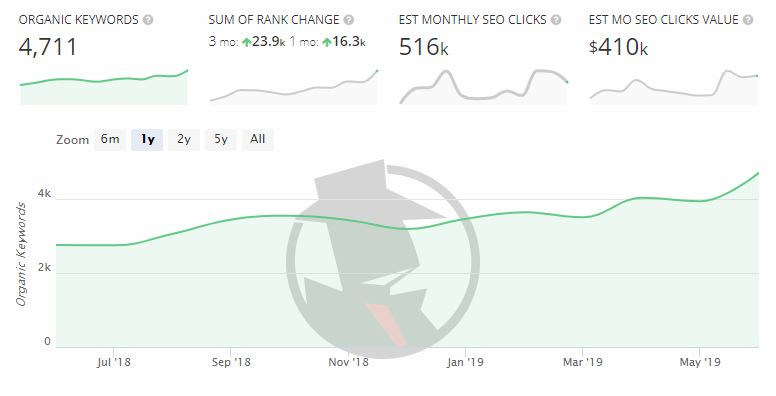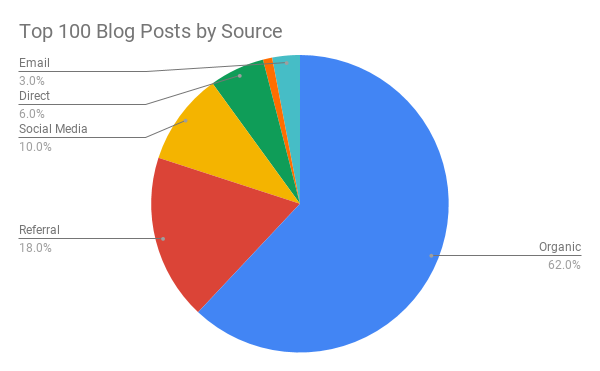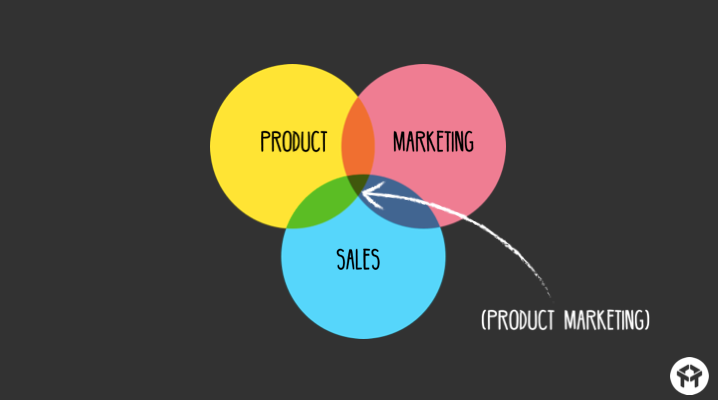When David Cancel founded Drift, he intentionally went after a competitive industry: website chat. Dave has an unorthodox view on starting companies: He prefers to go into industries that have plenty of competition because that means there actually is a market there.
The company was able to differentiate itself by focusing on brand before everything else. In their book This Won’t Scale, Drift’s marketing team talks about how their first task was to build a brand. That’s not something that many companies try to do right off the bat.
One of the things they’ve done to build their brand is focus on creating 10x content or, as Drift calls it, “six star content.” No matter what you call it, their overall approach is clear: Create better content than anyone else. The problem is that the word “better” is ambiguous.
That’s why we wanted to know, what does “better” mean to Drift? We used SpyFu to reverse engineer Drift’s content strategy so you can see what makes their content better than anyone else’s.
An SEO Overview
As a whole, Drift’s website ranks for 4,711 keywords. Over the past year, they’ve added about 2,000 new keywords to their mix. Both are great numbers, which suggests they’re doing something right with their website strategy.

When it comes to website behavior, Drift performs really well. The average time on page for all blog posts is 01:17, and their bounce rate is a ridiculously low 25.95%. To put that into perspective, HubSpot’s average time on page for their blog is 01:07, and their bounce rate is 57.52%.
The biggest reason for Drift’s increase in keyword rankings and great website behavior numbers is a smart content strategy that consists of blog posts, podcasts, books, and webinars.
The Central Piece to Drift’s Content Strategy: Their Blog
Although all of the content formats Drift uses are important to their overall content strategy, the blog is the foundation for each type of content. Each podcast they publish, webinar they perform, and video they film is reformatted for Drift’s blog.
That’s why we’re focusing on the blog to breakdown their content strategy.
Our first step in examining Drift’s blog was to look at their top 100 blog posts, based on the traffic numbers of each post.
We categorized each post into one of six categories:
- TOFU: These are top-of-funnel posts that are typically designed to capture organic search traffic and introduce a visitor to the brand. An example of this type of post would be “Account-Based Marketing (ABM): A Complete Guide.”
- Case Study: These are posts that explain how someone used Drift’s software to do something. For example, "Here's How a Fortune 500 Company Switched Over from Intercom and Booked 15X More Meetings with Drift" is a case study.
- Branded: These posts are centered on the brand or branded terms like “conversational marketing” and “hypergrowth.” Their post “What Is Hypergrowth? (And How Do You Achieve It?)” falls into the branded category because “hypergrowth” is a concept that Drift invented.
- Thought Leadership: These posts are typically designed to be widely shared on social media. Posts in this category are typically written by a senior member of Drift’s team. They don’t focus on any keyword specifically, but they are good attention-grabbers, which is why these posts work well on social media. “The Five Ego Traps Everybody Keeps Falling Into (And How to Avoid Them)” is a perfect example of a thought-leadership post.
- Product: These are posts that are centered on Drift’s product. Typically, this would be a product announcement or a “how-to” post like “The Free Guide To Using Drift.”
- Podcast: While podcasts can fall into any of these categories, we wanted to separate podcasts out to show how Drift uses them as blog content. “The Power Of Copywriting (And Two Tips To Help You Sell With Your Writing)” is a podcast post, but it could also be considered a TOFU post.
After categorizing Drift’s top 100 posts, we charted the breakdown:

Drift’s content mix is diverse, which is good to see. A diverse content mix means they’re not overly focused on top-of-the-funnel or bottom-of-the-funnel content. This mix helps their audience move down Drift’s marketing funnel. TOFU content takes up the largest section, coming in at 42% of their content. Typically, you want your TOFU content to make up the largest chunk of your overall content mix because that means you’re casting a wider net with organic search. Drift has this one figured out.
Case-study posts, on the other hand, are the smallest segment, with just 8%. That’s not a bad thing. Case-study posts are typically considered the bottom of the marketing funnel, meaning those are the posts that will get the most conversions to free trials or customers. You usually want to have fewer case studies but make them as strong as possible. Drift is good at this.
What’s really interesting is the fact that branded, case-study, and product posts make up 35% of Drift’s top blog posts. That means that over one-third of Drift’s blog posts are about themselves. This is slightly unusual, but, when done right, it can be a good thing.
Typically, you wouldn’t want to focus on yourself so much in your blog. It’s a turnoff to readers. No one wants to read a blog about how great your company is. Drift, though, manages to focus on themselves without bragging or showing off. It’s incredibly difficult to pull this off, but it seems like they’ve done it.
Podcasts are a big part of Drift’s blog strategy. Every time they publish a new podcast, they create a blog post to embed the podcast into. This strategy seems to be working well since 14% of Drift’s top blog posts are about one of their podcasts.
Where is the traffic coming from?
Traffic is great, but a more important question is: Where is this traffic coming from? Drift has shown that they have the ability to drive traffic to their blog posts, but if it’s all paid traffic, that’s much less impressive.
That’s why my next step was to look at the most popular traffic sources for Drift’s top 100 blog posts. I did the same thing and categorized each post by it’s most common source.

An overwhelming majority of Drift’s blog posts, 62%, get most of their traffic from organic sources. That’s exceptionally good. Social media is the top source for 10% of Drift’s posts. Advertising makes up only 1% of Drift’s top sources for their blog posts.
That means 99 out of 100 of Drift’s top blog posts get the majority of their traffic from an unpaid source — whether that’s organic search, organic social, email, or backlinks on other websites.
5 rules that make Drift’s content successful
What are you supposed to learn from this data? Good question. The team here spent a lot of time discussing this data, and we came up with five things that make Drift’s content successful.
1) Drift Tightly focuses on four different audiences.
Drift clearly focuses on one of four different audiences with each blog post. Their target audiences are marketers, salespeople, product managers, and entrepreneurs. This works because it balances between being too narrow with their blog content and going too wide.
If their blog as a whole only focused on only one audience, Drift might miss out on business from the other three audiences. Since they target all four audiences in different posts, they’re reaching all four audiences in different ways.
If they tried to go after more audiences, they might not be focused enough. As a result, they’d end up with a lot of average content, which wouldn’t achieve their “six star content” goal.
Your content should take the same approach. Before you start writing, know exactly who you’re writing for, and then focus on writing for those groups, and only those groups. That’s the formula for success.
2) Drift often features other companies in their content.
Many of Drift’s TOFU blog posts feature other companies. They write growth studies on companies like Segment, Zoom, Mailchimp, and more. This is a great tactic for opening your content to other audiences.
If you’re scrolling through Twitter and see a growth-study blog post about Slack, and one about Zac’s Ice Cream Shop, which one would you be more likely to click on? My guess is that you’re going to click on the growth study about the company you know (and possibly use).
3) They follow SEO best practices.
Drift plays by some SEO rules. Their URLs are always structured in a way that keeps them short and includes the keyword. Take the post “The Value Of Live Chat: Comparing Email and Chat Conversion Rates” as an example. The title itself isn’t too long, but the URL is really short: /blog/value-of-live-chat/.
That’s a perfect example of how to structure your URLs. Put the keyword in there, and not much else.
Drift also has well-written meta-descriptions for each blog post. I often see blogs that skip this step. Although meta-descriptions aren’t used as a ranking factor, a well-written meta-description can increase click-through rate from organic search.
Another best practice that Drift follows is that they regularly update their older blog posts. I saw multiple posts with editor’s notes like this one:

This suggests that they’re paying attention to content decay, which is when organic traffic to a blog post declines over time. Drift is taking steps to reduce content decay by updating their popular blogs periodically.
Drift does break some rules too.
Word count is a good example. Drift doesn’t seem overly concerned by the word counts of their blog posts. Some posts have as few as 163 words. On the flip side, this post on increasing conversion rates has 3,405 words. There’s a lot of research out there that says your blog posts should be around 2,500 words. Drift doesn’t seem to follow that best practice, but it doesn’t seem to be hurting them.
4) Drift is great at mixing content types.
One of the best things about Drift’s content is how often they mix other content types into blog posts. They use multiple images in every post, but they aren’t using stock images. Most images are simple designs that help further explain the blog post. Here’s a perfect example from a post about product marketing:

Drift also uses plenty of video and audio clips in their posts.
This content mix does a few things:
- It helps break up walls of text, which you see on many other blogs. That keeps the reader engaged and moving down the page.
- It gives Drift plenty of ways to reuse the same content. They can use the images and videos on social media as stand-alone posts. They can also use those images and videos as attention grabbers on social to drive traffic back to their blog.
- It creates referral traffic. This post about driving growth, for example, has a video embedded in it. That video is hosted by YouTube, and the video description has a link to the blog post. We know this works to drive traffic to that post because the top traffic source for that post is YouTube.
5) Drift knows the value of backlinks.
The percentage of posts that get the majority of their traffic from organic sources is huge: 62%. That’s a result of a really high number of backlinks to their website as a whole. According to our research, Drift has 3,763,749 backlinks.
Drift has an easy way to get backlinks to their website. The free version of Drift automatically includes a backlink to Drift’s website. So any company that installs the free version of Drift on their website is automatically passing a backlink back to Drift. It is a really smart strategy and is a big reason why Drift’s organic search percentage is so high.
Drift’s individual blog posts also get plenty of backlinks. That suggests that their content is living up to their goals of being “better” than any other content on the same topic.
Drift’s content is helpful
The reason Drift’s content works above everything else is that all of their content is aimed at helping their audience. Even product-update blog posts provide more value than just talking about the product.
That’s the biggest thing you should take away from this post. Focus on creating helpful, high-quality content and the other metrics will fall into line.
Drift has shown that you can create a brand on the back of great content, even if you operate in a really competitive industry.

